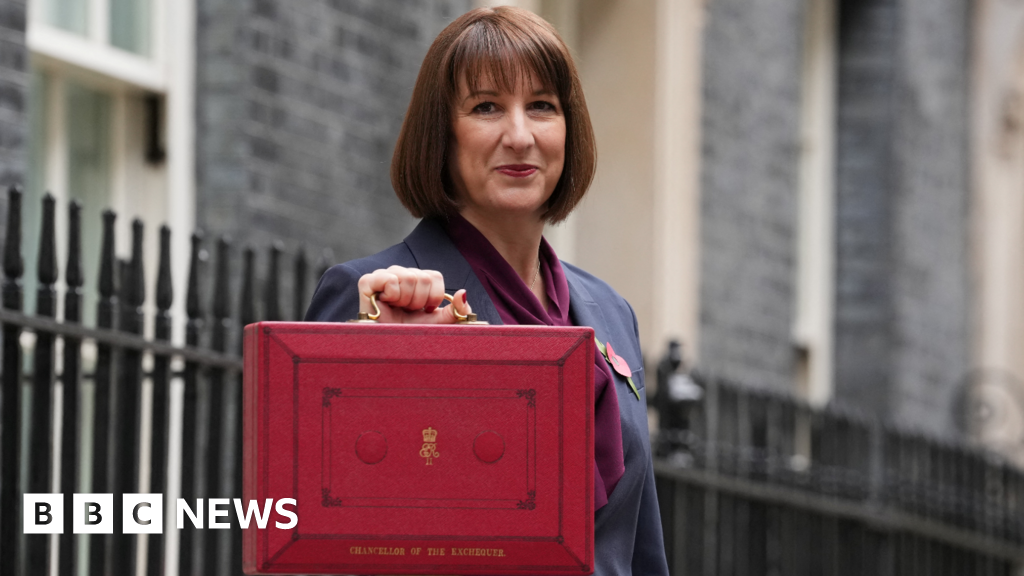Business
When is the Budget and what might be in it?

Chancellor Rachel Reeves has acknowledged she is considering tax rises and spending cuts ahead of her autumn Budget on 26 November.
Before the 2024 general election, Labour promised not to increase income tax, National Insurance or VAT for working people.
But the Institute for Fiscal Studies (IFS) says she will “almost certainly” have to raise taxes to make up a £22bn shortfall in the government’s finances.
The chancellor of the exchequer’s Budget statement outlines government plans for raising or cutting taxes. It also includes big decisions about spending on public services such as health, schools and police.
The statement is made to MPs in the House of Commons. It usually starts at about 12:30 UK time – after Prime Minister’s Questions – and lasts for about an hour.
The Leader of the Opposition, Conservative MP Kemi Badenoch, will give an immediate response. MPs will then debate the measures for four days, before voting on them.
There has been a lot of speculation that Reeves will have to raise taxes because she needs more money in order to meet her self-imposed rules for government finances.
She has two main rules, which she describes as “non-negotiable”:
- Not to borrow to fund day-to-day public spending by the end of this parliament
- To get government debt falling as a share of national income by the end of this parliament
The IFS said finding £22bn would allow the government to maintain the £10bn buffer it currently has, but argued there was a “strong case” for trying to increase it further.
The £10bn margin Reeves left herself after her Spring Statement in March was one of the lowest a chancellor has given themselves since 2010, with the average for the period standing at £30bn.
Income Tax and National Insurance (NI)
The government could extend the current freeze on income tax and NI thresholds, which is due to end in 2028.
Freezing the thresholds means that, as salaries rise over time, more people reach an income level at which they start paying tax or qualify for higher rates. This is often referred to as a “stealth tax”.
Speaking to the BBC in September, Reeves did not rule out extending the freeze.
The Resolution Foundation think tank – which has close links to some members of the government – believes some personal taxes will have to rise.
As part of a package of measures, it recommended cutting 2p from the employee NI rate, while adding the same amount to income tax.
Such a move would potentially affect pensioners, landlords and the self-employed more than workers. Their tax would increase but they wouldn’t benefit from a matched cut to NI.
Reeves has signalled that she is likely to focus on wealthy individuals, arguing “those with the broadest shoulders should pay their fair share”.
She may change the rules for limited liability partnerships (LLPs), which are sometimes used by high earning professionals such as lawyers and accountants.
Those who operate as LLPs are treated as self-employed and do not have to pay employers’ NI. The Times reported that changing this could raise £2bn.
Help with the cost of living
In October, Reeves told the BBC that she would take “targeted action to deal with cost of living challenges” while inflation remains high.
The BBC understands that the government could intervene to bring down gas and electricity bills. This could happen by reducing some regulatory levies currently added to bills, or by cutting the current 5% rate of VAT charged on energy.
The Sunday Times previously reported that it might fall to zero.
Property taxes
Reports suggest the government may reform property taxes. This could include replacing stamp duty – a tax buyers pay on properties above a certain value in England and Northern Ireland – with a property tax.
Landlords could have to pay more taxes, and council tax could be replaced.
Some people selling their main residence may have to pay capital gains tax.
Youth employment guarantee
In September, Reeves said that young people who have been out of work for 18 months will be given paid placements to help them secure full-time employment.
Isa reform
In July, the chancellor ruled out any immediate reform to cash Isas (Individual Savings Accounts). There had been speculation that she wanted to reduce the annual allowance to push people into investing in shares instead.
However, the FT has reported that she may announce a cut in the cash ISA limit from the current £20,000 to £10,000.
Pension changes
There has also been speculation about possible changes to pension rules, such as the level of tax relief available to savers and the size of the cash lump sum which can be withdrawn.
Cutting the higher rate tax relief on pension contributions would save the Treasury money, but may make pension savings less attractive.
Business taxes
The TUC, the umbrella group for trade unions in the UK, has called for higher taxes on online gaming companies and on banks’ profits.
In September, the chancellor told ITV News that “there is a case for gambling firms paying more”.
The Sunday Times reported that William Hill owner Evoke could close up to 200 of the chain’s betting shops in an attempt to stem losses, with the exact number being influenced by any changes to taxes on the sector.
Inheritance tax
In last year’s Budget, the government said that from April 2026, inherited agricultural assets worth more than £1m, which were previously exempt from inheritance tax, would be taxed at a rate of 20%.
In October, the Sunday Times reported that ministers were exploring changes to this, However, Farming Minister Dame Angela Eagle told the BBC’s Farming Today programme there was “no likelihood” of the policy being changed.
The Labour government says that boosting the economy is a key priority.
A growing economy usually means people spend more, extra jobs are created, more tax is paid and workers get better pay rises.
The UK economy has been slowing in recent months after a strong start to 2025.
The latest figures show that the economy grew by 0.1% in August, after a 0.1% contraction in July.
Over the three months to August, UK GDP grew by 0.3%, down from the 0.6% growth seen between March and May.
Meanwhile, government borrowing – the difference between public spending and tax income – reached £20.2bn in September. That was the highest level seen for the month in five years, driven by an increase in debt interest payments.
Prices are also still rising faster than expected.
Inflation held steady at 3.8% in the year to September, the same as in July and August, which was lower than expected, but still above the Bank of England’s 2% target.
In August, the Bank cut interest rates for the fifth time in a year, taking the cost of borrowing to the lowest level for more than two years.
It made the cut because of concerns that the jobs market was weakening, with data showing job vacancies were continuing to fall and wage growth was slowing.
However, the Bank held rates at its next meeting in September, arguing the UK was “not out of the woods” on inflation.
In October, the International Monetary Fund (IMF) forecast that the UK was set to be the second-fastest-growing major economy in 2025.
However, it also predicted that the UK will face the highest rate of inflation among G7 nations in both 2025 and 2026, driven by rising energy and utility bills.
Business
Why has the price of silver hit a record high?

The price of silver has hit a record high ahead of an expected US Federal Reserve interest rate cut and as demand from the technology industry for the precious metal remains high.
Silver crossed $60 (£45.10) an ounce on the spot market, where the precious metal is bought and sold for immediate delivery, for the first time on Tuesday.
Gold, which hit record highs earlier this year as concerns grew about the impact of US tariffs and the global economic outlook, also made gains this week.
Investors tend to move money into precious metals like gold and silver as interest rates come down and the US dollar weakens.
The US central bank is widely expected to cut its main interest rate by a quarter of a percentage point on Wednesday.
When interest rates are cut, traders typically buy assets like silver because the benefits of keeping cash in the bank or buying short-term bonds falls, said Yeow Hee Chua from the Nanyang Technological University.
“That naturally shifts demand toward assets viewed as stores of value, including silver,” he said.
The move into so-called “safe-haven” assets was also a key reason for gold hitting new record highs in recent months, as it crossed $4,000 an ounce for the first time.
Silver’s rally could also be seen a “spillover effect” from the jump in the value of gold as investors look for cheaper alternatives, said OCBC bank analyst Christopher Wong.
Gold has gained more than 50% this year, partly due to major purchases by central banks. The price of platinum and palladium have also climbed this year.
Experts say the value of silver was also pushed up as strong demand from the technology industry outstripped supplies.
That has helped more than double the value of silver this year as it outperformed other precious metals, including gold.
“Silver is not only an investment asset but also a physical resource,” and more manufacturers are finding a need for the material, said Kosmas Marinakis from the Singapore Management University.
The precious metal, which conducts electricity better than gold or copper, is used to produce goods like electric vehicles (EVs) and solar panels.
Experts predict that rising sales of EVs will further push up demand for silver, while advanced batteries for the cars will require even more of the metal.
But it is difficult to quickly increase silver supplies as the majority of global output is a by-product from mines that mainly extract other metals like lead, copper or gold.
The price of silver is also being boosted by concerns that the US may impose tariffs on it as part of President Donald Trump’s trade policies.
Fears of potential tariffs have also led to stockpiling of silver in the US, resulting in shortages elsewhere in the world.
The US imports about two-thirds of its silver, which is used for manufacturing as well as jewellery and investment.
Manufacturers have been racing to secure supplies to ensure their operations are not interrupted by shortages, which has helped to push up prices on global markets, said Prof Marinakis.
He added that he expects the price of silver to remain high in the coming months.
Business
Amazon To Invest $35 Billion In India By 2030 With Focus On AI-Driven Digitalisation

Last Updated:
“Amazon to date has invested USD 40 billion in India since 2010. Now we will invest another USD 35 billion by 2030 across all our businesses in India,” Agarwal said.
Amazon To Invest USD 35 Bn In India By 2030 With Focus On AI-Driven Digitalisation
E-commerce giant Amazon is set to invest a mega-investment of USD 35 billion, over Rs 3.14 lakh crore, in India by 2030 across its businesses with a focus on AI-driven digitisation, export growth and job creation, a senior company official said on Wednesday.
Senior VP Emerging Markets, Amit Agarwal, made the announcement during the Amazon Smbhav Summit, saying the company has set a target to quadruple exports from India to USD 80 billion from about USD 20 billion.
“Amazon to date has invested USD 40 billion in India since 2010. Now we will invest another USD 35 billion by 2030 across all our businesses in India,” Agarwal said.
Amazon’s investment plan is two times of Microsoft’s investment plan of USD 17.5 billion and close to 2.3 times that of Google’s USD 15 billion investment plan by 2030.
With this investment, Amazon will become the largest foreign investor in India, according to a Keystone report compiled from publicly available data.
In May 2023, Amazon announced plans to invest USD 12.7 billion in India by 2030 into its local cloud and AI infrastructure across Telangana and Maharashtra. The company has already invested USD 3.7 billion in India between 2016 and 2022.
The company has invested at scale towards building physical and digital infrastructure, including fulfilment centres, transportation networks, data centres, digital payments infrastructure and technology development.
According to the Keystone report, Amazon has digitized over 12 million small businesses and enabled USD 20 billion in cumulative ecommerce exports, while supporting approximately 2.8 million direct, indirect, induced and seasonal jobs across industries in India in 2024.
(With inputs from agencies)
December 10, 2025, 10:58 IST
Read More
Business
Stock market today: Nifty50 opens above 25,850; BSE Sensex up over 100 points – The Times of India

Stock market today: Nifty50 and BSE Sensex, the Indian equity benchmark indices, opened in green on Wednesday. While Nifty50 was above 25,850, BSE Sensex was up over 100 points. At 9:17 AM, Nifty50 was trading at 25,865.25, up 26 points or 0.099%. BSE Sensex was at 84,804.28, up 138 points.Dr. VK Vijayakumar, Chief Investment Strategist, Geojit Investments Limited says, “As the year slowly draws to a close the market structure is becoming challenging. Heavy selling in the broader market is justified since valuations have been elevated and kept high only on the strength of liquidity. This is unsustainable. But the weakness in the overall market and sustained selling by FIIs are a bit disappointing. A major concern is the excessive delay in the finalisation of the US-India trade deal. A remark by President Trump yesterday that action should be taken on India for dumping rice in the US hurt sentiments further.”“Fundamentals are turning in favour of India. Higher growth and corporate earnings are achievable in the quarters ahead. The fiscal and monetary stimulus provided this year have started producing results. The excessively low inflation rate, which impacted nominal GDP growth, also will start rising in the coming quarters. This is significant since corporate earnings growth will be influenced more by nominal GDP growth rather than by real GDP growth. The fact that valuations in the large cap segment have become fair is another positive. These positive factors will start weighing on the market soon. Investors have to keep faith and wait patiently for the fundamentals to play out.”The S&P 500 declined on Tuesday as investors anticipated hawkish Federal Reserve messaging despite potential rate cuts. JPMorgan contributed significantly to the benchmark index’s decline following the bank’s announcement of substantial 2026 expenses.Asian markets showed modest gains following Wall Street’s subdued session, with investors awaiting the Federal Reserve’s final interest rate decision of the year.Foreign portfolio investors recorded net sales of Rs 3,760 crore on Tuesday, whilst domestic institutional investors showed net purchases of Rs 6,225 crore.(Disclaimer: Recommendations and views on the stock market, other asset classes or personal finance management tips given by experts are their own. These opinions do not represent the views of The Times of India)
-

 Business1 week ago
Business1 week agoCredit Card Spends Ease In October As Point‑Of‑Sale Transactions Grow 22%
-

 Tech1 week ago
Tech1 week agoHow to build a data dream team | Computer Weekly
-

 Tech1 week ago
Tech1 week agoI Test Amazon Devices for a Living. Here’s What to Buy This Cyber Monday Weekend
-

 Tech1 week ago
Tech1 week agoThe 171 Very Best Cyber Monday Deals on Gear We Loved Testing
-

 Business1 week ago
Business1 week agoIndiGo Receives Rs 117.52 Crore Penalty Over Input Tax Credit Denial
-

 Fashion1 week ago
Fashion1 week agoEastpak appoints Marie Gras as vice president, global brand
-

 Business1 week ago
Business1 week agoGold And Silver Prices Today, December 2: Check 24 & 22 Carat Rates In Delhi, Mumbai And Other Cities
-

 Fashion1 week ago
Fashion1 week agoNorth India cotton yarn prices steady on average demand






